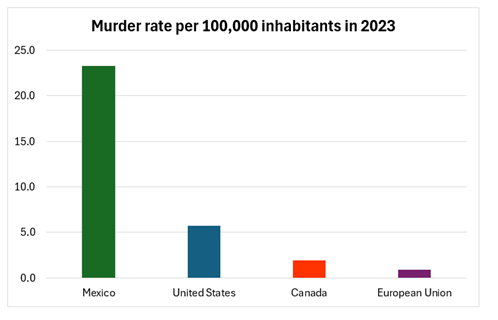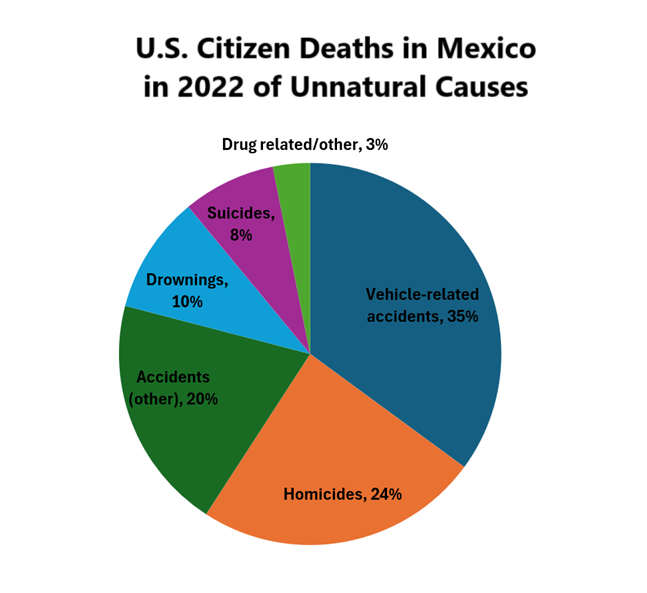Foreign media relentlessly amplify the dangers of visiting (or living in) Mexico. But those of us who spend real time here know that safety risks vary widely by location, with violent crime rarely affecting foreign visitors and residents. To illustrate, this article will examine violent crime in Mexico in 2025 alongside the most recent data on violent crime against U.S. citizens here.
Before we dive in, I’d like to share an example of what we’re up against with regard to the media. While researching violent crime in Mexico, I came across this quote widely shared by various major U.S. news outlets ahead of the 2025 Spring Break vacation season.
“If you leave the resort, you’re definitely at high risk, especially if you’re an American female. You’re at risk of kidnapping or being sold into the sex trade. Anywhere in Mexico outside the resort is highly dangerous.” — Retired DEA Special Agent Michael Brown.
If this guy is right, expats like me are lucky to be alive. On the other hand…
Maybe this ex-cop isn’t great with numbers, didn’t bother to look at them, or … his current line of work depends on keeping people afraid.
To counter this corrosive fear-mongering and help you make more informed decisions, let’s look at what’s actually going on.
Who Faces the Greatest Risk of Violence in Mexico
It’s true that Mexico has more violent crime per capita than the U.S., Canada, or Europe.
Mexico’s homicide rate is roughly four times higher than the U.S., twelve times higher than Canada, and more than 20x the European Union’s murder rate, based on 2023 data.

But there’s no need to shift your vacation (or relocation) plans to Spain. It’s a mistake for a foreign visitor to conclude their risk of dying violently in Mexico is four times higher than it is in the U.S. What the media and others typically miss is the key details behind those numbers, i.e., who’s at risk and who isn’t.
So let me state it clearly…
People at the highest risk of an unnatural death in Mexico are those involved with the drug cartels, i.e., people making, selling, buying, and transporting drugs, and those protecting the cartels’ interests (a wide range of jobs).
Other key groups at high risk of untimely death are the police, journalists, and politicians. If you’d like to learn more about why that is, check out my previous crime article here.
For the rest of us (Mexicans and foreign visitors alike), the risk of dying a violent death in Mexico is pretty small if you use common sense. To illustrate, let’s take a look at Mexico’s violent crime numbers over the past 12 months.
Violent Crime in Popular Tourist Cities in Mexico
The table below shows homicide rates in popular destinations for foreign tourists in the past 12 months.

As you can see, the risk profile of these cities varies widely. Beach resorts like Tulum and Acapulco are seeing murder rates well above the national average due to cartels warring for control of these lucrative resort towns. Popular destinations in Mexico’s Central Highlands, San Miguel de Allende and Cuernavaca, are also experiencing more violent crime than the country as a whole.
The bad news for Colima is that it still ranks number one for its murder rate (roughly 4x higher than the national average). The good news is that it’s not nearly as bad as the previous 12 months. Colima, I’m rooting for you to lose the top slot next year!
At the other end of the spectrum, visitor hotspots like Mexico City, Oaxaca, and Puerto Vallarta see far lower homicide rates than Mexico overall. And popular expat destination Merida continues to distinguish itself as the safest city in Mexico. (but the heat and humidity still might kill you 😉
This is not to say that Mexico’s powerful cartels aren’t present in the safest parts of the country. Quite the contrary. Safe cities are typically characterized by one cartel having total dominance in that area.
Other Types of Violent Crime in Mexico in 2025
The data below shows the annual crime rate per 100,000 inhabitants for the 12 months ending in April 2025 for the most dangerous states in three other violent crime categories: robbery/extortion, kidnapping, and violent carjackings. City-level data isn’t available in these categories for the past year.
Robbery/extortion: Baja Sur (22.7), Guanajuato (21.3), Morelia (21)
This is one category where crime has been rising at the national level in recent years, and the risks are broadly dispersed across the country.
One notorious case in Baja recently involved foreign tourists. Three expat surfers (two Australians and one American) were killed outside of Ensenada in 2024. They had been camping in a rural area and were likely victims of a botched car robbery.
Kidnapping: Chihuahua (5.4), Sonora (1.5), the rest are much lower
Kidnapping is heavily concentrated in the northern border zone, and often involves desperate immigrants seeking to enter the United States (doubly sad).
It’s not a “thing” you need to worry about in the rest of Mexico. Special Agent Brown, call your office.
While immigrant crossing volumes have fluctuated wildly in recent years, kidnappings have fortunately been dropping off from their high point back in 2019.
Violent carjackings: Sinaloa (138.4), Morelia (63.7), the rest are much lower
Like kidnapping, violent carjackings have also been falling at the national level from their peak back in 2018.
Regarding the past 12 months, the data emphatically underline the risk of driving through Sinaloa. And carjackings aside, it’s a good idea to give this state a miss right now anyway due to the ongoing civil war within the Sinaloa cartel, as rival factions fight for control.
U.S. Citizen Deaths in Mexico
The U.S. government compiles detailed data on U.S. citizen deaths that’s easy to get hold of. But because it’s only published once every two years (past practice), it’s very dated — with 2022 figures being the most recent available.
Who can say if these reports will still get prepared under President Trump, now that the State Department’s ranks have been gutted?
Leaving that question aside, I’ve broken down the data on U.S. citizen deaths in Mexico from 2022 (the most recent available) to help you understand the various risks U.S. citizens face in Mexico relative to the general crime rate in that year.

Overall, 191 Americans died of “unnatural” causes in Mexico in 2022. About two-thirds were due to accidents (drownings, car accidents, other), 24% were by homicide, and the remaining 11% were from various types of self-harm (drug overdoses, suicides).
Based on roughly 28 million U.S. tourist visitors and 1 million U.S. expat residents of Mexico in 2022, the homicide rate for U.S. citizens that year was 0.2 per 100,000 versus 25 per 100,000 for the general population.
In other words, a U.S. citizen had a greater risk of death in Mexico by getting in a car versus falling victim to cartel violence, assuming you weren’t involved in the drug trade. Additionally, if you visited beach resorts in Quintana Roo or Puerto Vallarta, you were more likely to die of an accident or self-harm than from cartel violence.
Government data, which you can view here, shows the northern border zone is far and away the most dangerous for U.S. citizens. This area was responsible for 74% of American deaths by homicide in Mexico in 2022. Tijuana and Juarez together accounted for an astonishing 54% of the total.
The rest of Mexico accounted for the remaining 26% (12 homicides). It’s worth noting that there were zero U.S. citizen homicides in Mexico City, Puerto Vallarta, Queretaro, San Miguel de Allende, Zapopan, Oaxaca, Morelia, Mazatlan, and Merida in 2022.
Guadalajara had one, and Monterrey had three. Even in Colima, where the general homicide rate was off the hook back in 2022, not a single U.S. citizen was killed there.
RULE OF THUMB: The cartels don’t target foreign visitors. U.S. citizen deaths bring them unwanted attention and government intervention — due to international pressure — to find the guilty parties. To put it crudely, these incidents are bad for business, so the cartels generally try to avoid them.
That’s not to say your risk from cartel violence is zero. In 2022, two Canadian visitors were shot dead at the Hotel Xcaret in Playa del Carmen. And in early 2024, a California woman was shot and killed while enjoying the pool at Mia Beach Club in Tulum.

Investigations found the Canadian victims had criminal histories and their deaths were cartel-related, while the American woman was an unintended victim of drug dealers’ crossfire.
Sources: elcri.men, SESNSP, INEGI, U.S. State Department, Statista, Fox News

